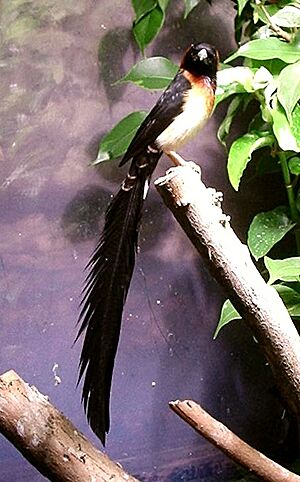Broad-tailed paradise whydah facts for kids
Quick facts for kids Broad-tailed paradise whydah |
|
|---|---|
 |
|
| Conservation status | |
| Scientific classification | |
| Genus: |
Vidua
|
| Species: |
obtusa
|
| Synonyms | |
|
|
The broad-tailed paradise whydah (Vidua obtusa) is a fascinating bird that belongs to the Viduidae family. You can find these birds in woodlands and open savannas across Sub-Saharan Africa. Their home stretches from Angola to countries like Uganda, Tanzania, and Mozambique. This bird is special because it's a brood parasite. This means it lays its eggs in the nests of other bird species! Even though it has this unique habit, the broad-tailed paradise whydah is found over a very large area. Because of its wide range, experts say it is not currently in danger of disappearing.
Contents
About the Broad-tailed Paradise Whydah
What Does It Look Like?
The broad-tailed paradise whydah looks different depending on if it's a male, female, or young bird, and if the male is ready to breed.
- Breeding Males: These males are quite long, about 31 to 36 centimeters (12 to 14 inches). They have very long tail feathers with rounded tips. They also have a bright chestnut-orange patch on the back of their neck.
- Nonbreeding Males and Females: When males are not breeding, they look much smaller, around 14 to 15 centimeters (5.5 to 6 inches) long. Females are also this size. Their undersides are a light, yellowish-brown color, and their upper parts are grey-brown with stripes. They have cool black and white stripes on their heads. Females weigh about 19.5 grams (0.7 ounces).
- Young Birds: Young whydahs look a lot like the females. However, some of their feathers have yellowish-brown edges, and their patterns are not as clear.
Where Do They Live?
These whydahs live in many countries across Africa. You can find them in Angola, Botswana, Burundi, the Democratic Republic of the Congo, Kenya, Malawi, Mozambique, Namibia, Rwanda, South Africa, Tanzania, Uganda, Zambia, and Zimbabwe. Their total living area is huge, covering about 5,060,000 square kilometers (about 1,950,000 square miles)!
They like to live in woodlands, especially types called miombo and Baikiaea plurijuga woodlands. They also enjoy living in acacia savannas, which are open grasslands with scattered acacia trees.
How Do They Behave?
The broad-tailed paradise whydah is famous for being a brood parasite. This means the female whydah lays her eggs in the nest of another bird species, and that other bird raises the whydah chicks as its own. The main bird they trick is the orange-winged pytilia (Pytilia afra). The orange-winged pytilia is much smaller, weighing only about 14 to 15 grams (0.5 ounces), so it's at a disadvantage!
- Mimicking Calls: The broad-tailed paradise whydah chicks are very clever. They can copy the calls of the orange-winged pytilia chicks. This helps them fit in and get food from their adopted parents.
- Eating Habits: These birds usually look for food on the ground in small groups. They mostly eat seeds.
- Social Life: When they are not breeding, broad-tailed paradise whydahs might mix with another similar bird called the long-tailed paradise whydah.
- Breeding Season: In some areas, like the southeastern Congo Basin, males are seen in their special breeding feathers from February to July.
- Eggs and Chicks: Their eggs are white and weigh about 1.6 grams (0.06 ounces). When they hatch, the baby whydahs have loose, grayish fuzz, which looks very similar to the chicks of the orange-winged pytilia.
- Sudden Appearances: Sometimes, a very large number of these birds can appear suddenly in one area. This is called an "irruption." For example, in 1994, thousands of whydahs were seen in Kasane, Botswana.
Is It Endangered?
No, the broad-tailed paradise whydah is not in danger. Experts from the IUCN Red List have assessed its status as "least concern." This is because the species lives across a very large area, and its population seems to be stable.


